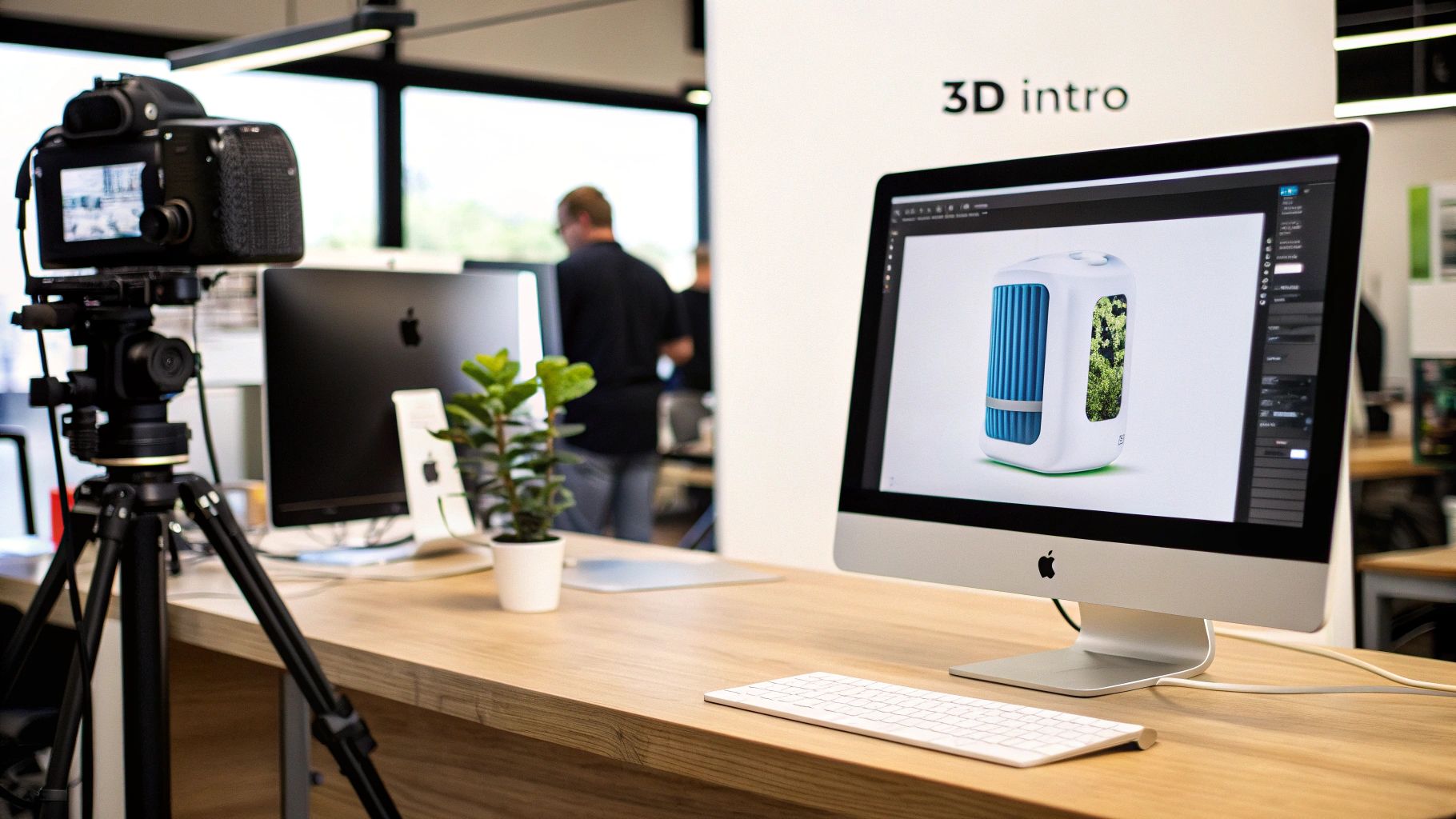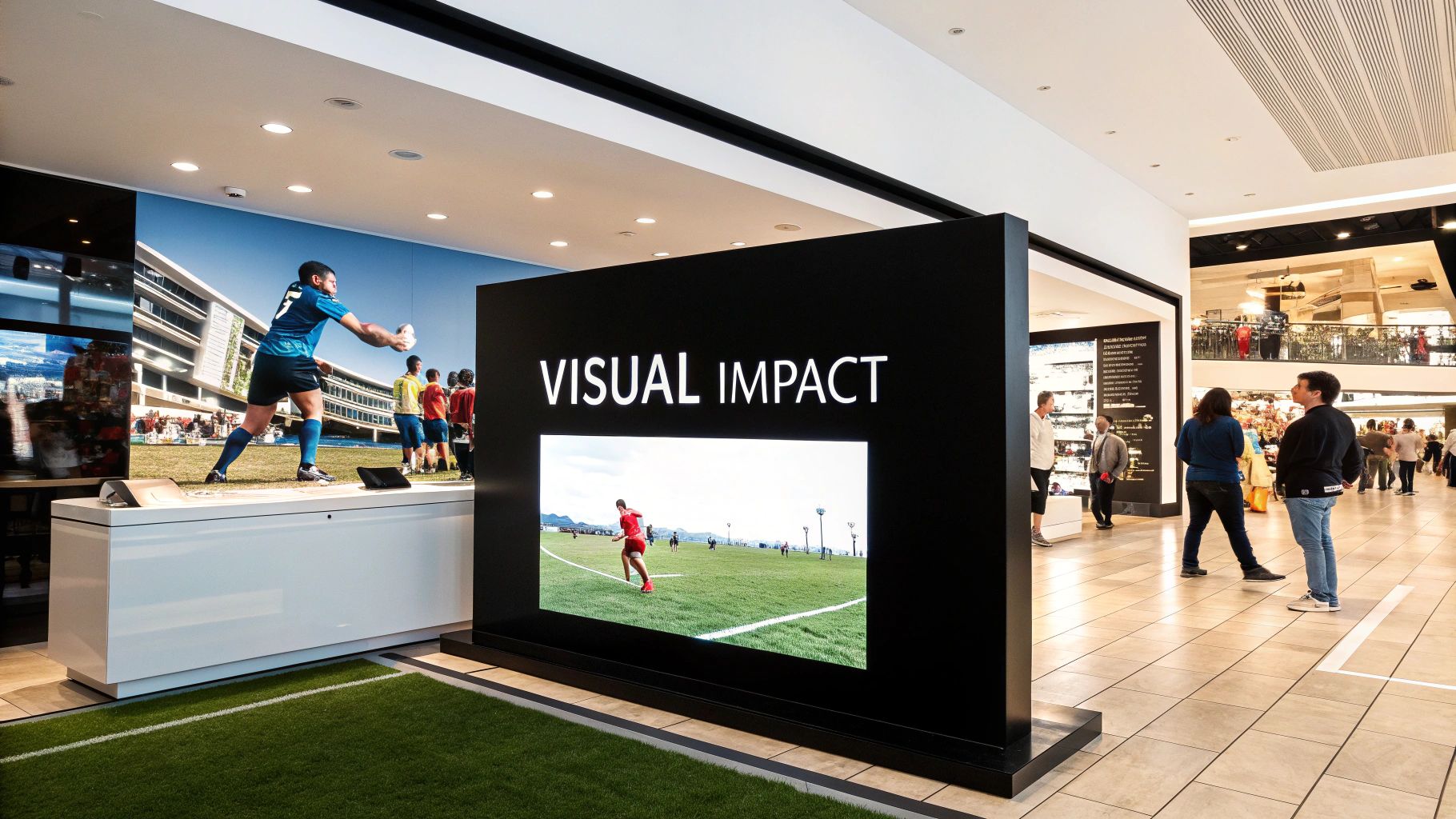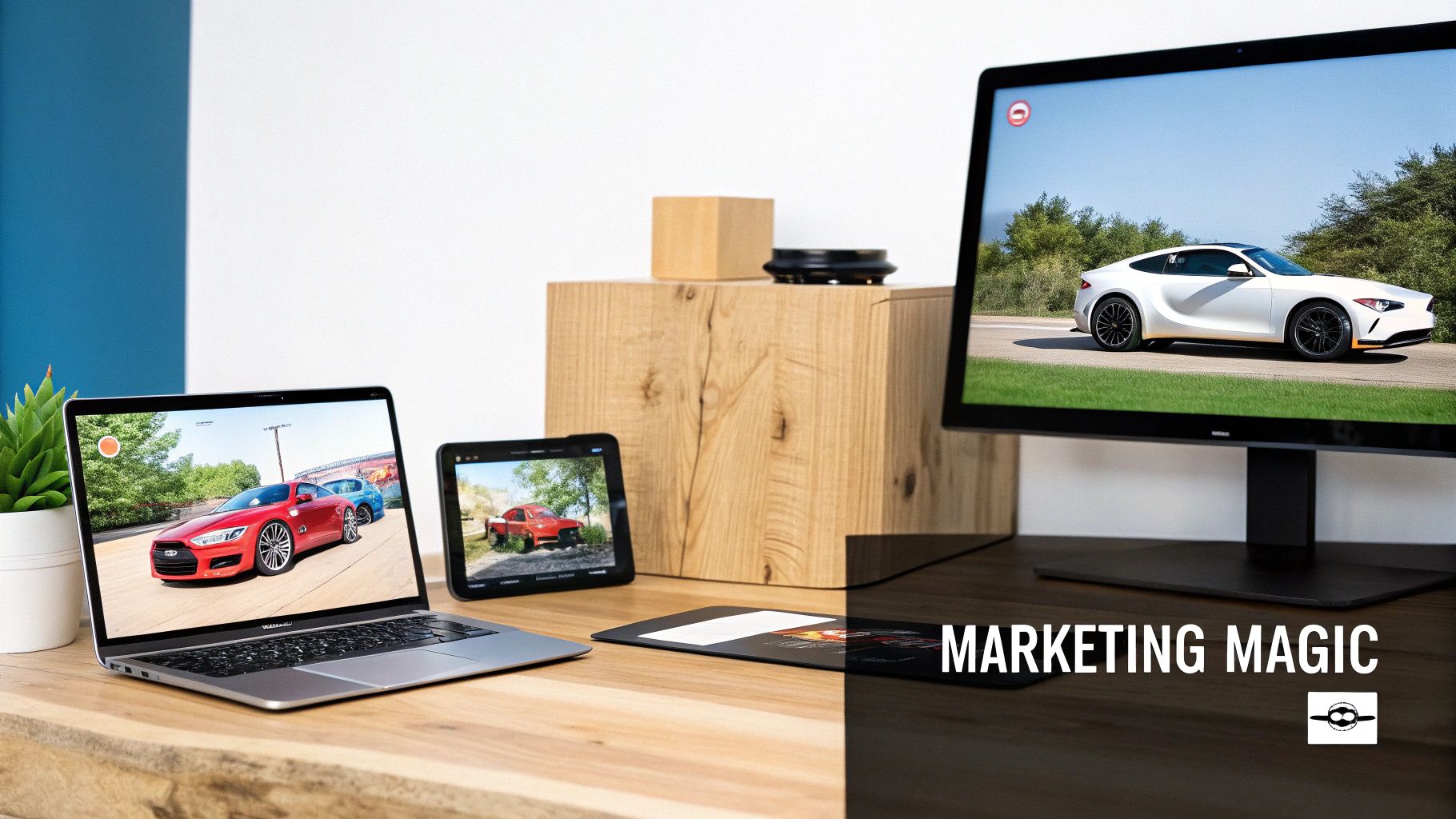Why 3D Product Animation Is Reshaping Brand Experiences

Capturing and keeping a customer's attention in today's competitive marketplace is a significant challenge. That's where the true strength of 3D product animation comes into play. It goes beyond static images, providing a dynamic and captivating way for brands to resonate with their audience.
3D product animation brings products to life, offering customers an experience that traditional photography simply can't match. This heightened level of interaction cultivates a deeper understanding and appreciation for the product's features and advantages.
Beyond Static Imagery: The Power of Interactive Experiences
Imagine examining a shoe from every angle, zooming in on its detailed stitching, and even observing how it bends with each step — all from your screen. This is the immersive experience that 3D product animation provides.
By showcasing products comprehensively and highlighting their unique functions, brands can craft a more compelling and convincing story. This interactive element significantly boosts engagement, transforming customers from passive viewers into active participants in exploring the product.
This increased engagement strengthens the connection with the brand and makes a purchase more likely.
The Psychology of Dimensional Storytelling
3D product animation is more than just visually appealing; it leverages the psychology of consumer behavior. Witnessing a product in action, understanding its mechanics, and visualizing its integration into their own lives creates a deeper emotional bond with potential customers.
This dimensional storytelling directly addresses purchase uncertainties. For instance, demonstrating a phone case's durability with a drop test animation can alleviate concerns about its protection. This proactive approach builds trust and confidence, leading to a smoother buying process.
The progress of 3D product animation is largely due to advancements in Computer-Generated Imagery (CGI). Interestingly, some of the initial CGI work involved creating short films of rigged pilots to evaluate their reach within aircraft cockpits.
This pioneering work established the groundwork for the modern 3D animation techniques used today. By the late 1960s and early 1970s, researchers were experimenting with realistic digital renderings of human hands and faces, which eventually appeared in mainstream media like the 1976 film Futureworld. Learn more about the history of 3D animation here.
From these early explorations, the field has grown exponentially, providing brands with unparalleled opportunities to engage their audiences dynamically and effectively. 3D product animation is not a passing fad; it represents a fundamental shift in how brands convey the value and experience of their products.
The Evolution That Made 3D Product Animation Accessible

Creating high-quality 3D product animation was once an exclusive domain for large corporations with substantial budgets. The process was intricate, lengthy, and demanded costly hardware and software. This left smaller businesses and startups at a disadvantage, unable to utilize 3D animation for their marketing. But technological progress has changed all that. Now, this powerful tool is more accessible than ever before.
This shift has significantly changed product marketing. Advancements in both software and hardware have dramatically reduced the time and expense of producing compelling 3D product animations. What once required specialized teams and vast rendering farms is now achievable with readily available tools and more efficient workflows. This opens exciting new opportunities for businesses of all sizes.
The Impact of Software Advancements
A primary driver of this democratization is the development of increasingly sophisticated and user-friendly 3D animation software. Programs like Autodesk Maya and Blender offer intuitive interfaces, powerful features, and automated processes that simplify complex tasks. This empowers users without extensive technical expertise to create stunning visuals.
Features like automated rigging and pre-built asset libraries significantly reduce the time needed for model setup and animation. Real-time rendering engines offer instant feedback, enabling quick iteration and experimentation. These enhancements have substantially lowered the barrier to entry for 3D product animation.
From Server Farms to Workstations
Hardware evolution is also crucial to this accessibility shift. Rendering complex 3D animations previously required powerful, and expensive, server farms. Advancements in processing power and graphics cards mean even standard workstations can now handle complex rendering tasks efficiently. This not only reduces costs but also grants creators more control over their projects.
The 1980s saw significant progress in using 3D animation in film. Movies like Tron showcased the potential of computer-generated visuals. Software like AutoCAD emerged, further expanding the possibilities of 3D modeling and design. Learn more about the history of 3D animation here. By the end of the decade, 3D animation was a Hollywood staple, paving the way for its widespread adoption in the 1990s and beyond.
Tangible Business Opportunities for All
This increased accessibility translates into concrete business benefits for companies of all sizes. Startups can now create compelling product demos and marketing materials affordably. Established businesses can enhance their visual storytelling and engage customers in dynamic new ways. The playing field has been leveled, allowing businesses to harness 3D product animation to connect with audiences and drive sales.
This accessibility not only means lower costs and faster production but also encourages greater creativity and innovation. With these tools, businesses can push creative boundaries and build engaging experiences for their customers. This enhances brand perception, increases audience engagement, and provides a stronger competitive edge.
Converting Viewers to Buyers With 3D Product Animation
3D product animation is more than just eye-catching; it's a powerful tool for boosting sales. It gives potential customers the information and confidence they need to click that "buy" button. Let's explore how 3D product animation transforms viewers into buyers.
Reducing Return Rates Through Enhanced Product Understanding
One key advantage of 3D product animation is its ability to minimize return rates. Static images can sometimes misrepresent a product's size, features, or how it works. This can lead to unhappy customers returning items. 3D animation lets customers virtually interact with the product. They can rotate it, zoom in, and even see it in action. This detailed view leads to fewer returns, as customers have a clearer understanding of what they're buying.
Imagine buying furniture online. A static image might not show the fabric's texture or the sofa's true size. A 3D animation could show the sofa from every angle. Customers could zoom in on the fabric and visualize it in their living room. This detail empowers informed decisions.
Faster Purchase Decisions Driven by Product Comprehension
3D product animations also encourage faster purchases. By showing a product's functionality dynamically, animations quickly answer questions and alleviate concerns. This reduces research time, leading to quicker conversions. This is especially helpful for complex products with intricate features, which are difficult to explain with text or static images.
This means businesses using 3D product animation often see a shorter sales cycle. Customers move through the buying process more efficiently, easily grasping the product’s value. This translates into increased sales and revenue growth.
The Impact of Animation on Social Sharing and Engagement
3D product animations excel on social media. They are more shareable and generate higher engagement than static images. This organic reach expands brand visibility and drives website traffic. Think about your own social media experience: what’s more likely to grab your attention – a static image or a captivating animation?
Interestingly, 3D animation's popularity surged after Toy Story in 1995. The first fully computer-animated feature film, Toy Story grossed over $362 million worldwide. It also showcased 3D animation's commercial potential, paving the way for its use in media like the television series Veggie Tales, the first fully 3D animated series in the United States. Learn more about the history of 3D animation here.
Strategic Animation for Conversions
Not all 3D product animations are equal. Animations that just entertain without highlighting selling points may not increase conversions. The most effective animations strategically showcase benefits, address customer questions, and guide viewers toward a purchase.
To illustrate the potential return on investment (ROI) of incorporating 3D product animation into your marketing strategy, let's look at some key metrics. The following table compares traditional product images with 3D product animation.
3D Product Animation ROI Metrics
| Metric | Traditional Product Images | 3D Product Animation | Percentage Improvement |
|---|---|---|---|
| Click-Through Rate | 2% | 5% | 150% |
| Conversion Rate | 1% | 3% | 200% |
| Average Order Value | $50 | $60 | 20% |
| Return Rate | 10% | 4% | 60% |
| Social Media Engagement | 500 interactions | 2000 interactions | 300% |
As you can see, 3D product animation offers significant improvements across various marketing metrics. From click-through rates to return rates, the impact is substantial.
In conclusion, 3D product animation offers a strong way to connect with your audience, build trust, and drive sales. By showcasing your products compellingly and interactively, you can transform passive viewers into engaged buyers, boosting your bottom line.
Creating Impactful 3D Product Animation: A Practical Guide

Moving from initial concept to final creation in 3D product animation demands a well-structured approach. This practical guide will navigate you through the essential production stages. We'll offer insights into crafting animations that truly connect with your target audience and effectively achieve your marketing objectives. Consider this your personal blueprint for constructing compelling 3D product animations.
Defining Your Objectives and Target Audience
Before delving into the specifics of software or storyboards, it's crucial to establish clear objectives. What do you hope to accomplish with your 3D product animation? Is your primary goal increased brand awareness, better conversion rates, or perhaps a deeper understanding of your product among consumers? This clarity will inform every decision you make going forward.
Equally important is understanding your target audience. Who are you trying to connect with through your animation? What are their interests, preferences, and online habits? A 3D product animation geared towards tech-savvy millennials will look vastly different from one designed for a more mature demographic.
Pre-Production: Planning Your 3D Product Animation
The pre-production phase lays the foundation for a successful animation. This stage involves crafting a comprehensive plan, including storyboarding, scripting, and establishing the overall visual style. Thorough preparation here can significantly reduce costly revisions later in the process.
Think of storyboarding as creating a comic book version of your animation. It visually maps out the essential scenes and actions, allowing you to visualize the animation's flow and timing. This is where your 3D product animation truly begins to take shape.
Production: Bringing Your Vision to Life
In the production phase, your animation starts to materialize. This stage encompasses modeling, texturing, rigging, and animating your product within a 3D environment. This phase relies heavily on specialized software like Blender and the expertise of skilled animators. The right tools and talent will significantly impact the final output.
Rigging is essentially creating a skeleton for your 3D model, enabling it to move and flex in a realistic manner. Think of it as the underlying framework that dictates your product's movement and actions. This is a key element for producing dynamic and engaging 3D product animations.
Post-Production: Polishing and Refining Your Animation
Post-production is the final step, where you polish and refine your creation. This includes adding lighting, special effects, sound design, and music. This phase is vital for creating a professional and impactful finished product. Subtle enhancements at this stage can greatly elevate the overall quality.
Interestingly, the increasing importance of 3D animation is reflected in the film industry. Between 1995 and 2005, the average effects budget for a major US film jumped from $5 million to $40 million, showcasing the growing reliance on CGI. By the early 2000s, CGI had become the leading special effects method. Learn more about the History of Computer Animation.
Optimizing for Different Platforms
When developing your 3D product animation, carefully consider its intended use. An animation for a website may need to be shorter and load quickly, while an animation for social media may need to be optimized for mobile viewing. Understanding these nuances is key.
Optimizing file sizes and resolutions ensures a seamless viewing experience, no matter where your audience encounters your 3D product animation. This helps ensure your message is conveyed effectively across various digital channels.
Tools That Power Exceptional 3D Product Animation

Creating stunning 3D product animation takes more than just a great idea. It requires the right tools. This section dives into the software, platforms, and resources that help animators make products truly come alive. We'll cover everything from industry-standard software to specialized plugins, examining what makes these tools so important for high-quality 3D product animation.
Essential 3D Animation Software
The core of any 3D product animation project is the software. Several powerful programs are industry mainstays, each with its own advantages and disadvantages.
To help you understand the landscape, let's take a closer look at some of the key players.
-
Autodesk Maya: Known for its robust features and adaptability, Autodesk Maya is often the go-to for complex animations and high-end visuals. Its advanced rigging and animation tools are perfect for creating realistic and dynamic product movements.
-
Blender: This free and open-source software offers a complete set of tools for modeling, animation, and rendering. Blender’s accessibility and active community make it an excellent choice for beginners and experienced animators alike.
-
Cinema 4D: This user-friendly software is appreciated for its intuitive interface and efficient workflow. Cinema 4D is a popular choice for product animations with a stylized or graphic look due to its focus on motion graphics.
-
3ds Max: Another Autodesk offering, 3ds Max excels at creating detailed and photorealistic visuals. Its powerful modeling tools and vast plugin library make it valuable across various industries, from product visualization to architectural design.
To summarize the key differences between these popular software options, we've compiled the following comparison table.
3D Animation Software Comparison for Product Animation
Detailed comparison of popular 3D animation software options for product visualization
| Software | Price | Learning Curve | Best For | Key Features | Limitations |
|---|---|---|---|---|---|
| Autodesk Maya | Subscription-based | Steep | Complex animations, high-end visuals | Advanced rigging, robust features | Cost, complexity |
| Blender | Free | Moderate | Beginners, versatile projects | Open-source, active community | Can lack some advanced features of paid software |
| Cinema 4D | Subscription-based | Moderate | Motion graphics, stylized animation | Intuitive interface, efficient workflow | Fewer plugins compared to Maya or 3ds Max |
| 3ds Max | Subscription-based | Steep | Photorealistic visuals, detailed modeling | Powerful modeling tools, extensive plugin library | Cost, complexity |
As you can see, the choice of software depends largely on project needs and budget.
Streamlining The Workflow With Plugins and Extensions
Beyond the core software, plugins and extensions add functionality and streamline workflows. These tools can drastically boost efficiency and give a final polish to 3D product animations.
-
Render Farms: Services like RebusFarm and GarageFarm.NET speed up rendering times. They do this by distributing the workload across multiple computers, allowing animators to finish projects faster and iterate more efficiently.
-
Texture Libraries: Resources like Poliigon and Substance Source provide high-quality textures and materials. This adds realism and depth to 3D models. Using these pre-made assets saves significant time and effort.
-
Specialized Plugins: Numerous plugins exist for specific tasks, such as hair and fur simulation, cloth dynamics, and advanced lighting. These tools help animators create more realistic and detailed product visualizations.
Strategic Software Selection For Budget and Project Needs
Choosing the right tools is key to balancing budget and project complexity. High-end software like Maya offers powerful features, but its cost and learning curve might be too much for smaller projects.
For simpler animations or tighter budgets, cost-effective options like Blender or Cinema 4D can deliver excellent results. Strategically using render farms can drastically cut down rendering times without needing expensive hardware. Finding the sweet spot is critical for efficient and effective 3D product animation.
What's Next: 3D Product Animation Trends Reshaping Marketing
The world of 3D product animation is in constant motion. To stay competitive, businesses need to understand the emerging technologies that are changing the game. This proactive approach allows companies to seize new opportunities and maintain a leading edge.
AI-Assisted Modeling: Streamlining Creation
One of the most significant developments is AI-assisted modeling. This technology is dramatically cutting down production time. AI algorithms can automate tedious tasks like creating complex shapes and textures, freeing up artists to focus on the creative aspects. This makes 3D product animation more accessible, even for companies with rapidly changing product lines.
Imagine a company launching a new phone every few months. Traditionally, creating a new 3D animation for each release would be a lengthy and costly process. With AI assistance, it becomes significantly faster and more affordable, allowing the company to keep pace with its product launches.
Augmented Reality Integration: An Interactive Shopping Experience
Augmented reality (AR) integration is changing how customers interact with 3D product animations. AR allows customers to visualize 3D models in their own space using their smartphones or tablets. This turns passive viewing into an engaging experience, directly influencing purchasing choices.
Early AR adopters are already seeing positive results. Customers using AR are more likely to grasp product details, build confidence in their purchase, and ultimately, buy. This immersive experience blends the digital and physical worlds, truly bringing products to life.
Real-Time Rendering: Personalized Product Exploration
Real-time rendering engines, initially designed for gaming, are opening exciting doors for 3D product animation. These engines power dynamic and interactive experiences. Customers can now configure products in real-time, selecting colors, materials, and features, and instantly see changes reflected in the 3D model.
This level of personalization empowers customers and strengthens their product understanding. This real-time interaction simplifies the purchase decision, leading to increased customer satisfaction.
Choosing the Right Technology for Your Business
While many exciting innovations are emerging, it's essential to separate practical business solutions from less viable advancements. Not every new technology is the right fit for every business. Focus on advancements that align with your specific marketing goals and resonate with your target audience.
By concentrating on trends with practical advantages and addressing real customer needs, businesses can maximize their return on investment and achieve their marketing objectives. This strategic approach helps ensure that investments in new technology deliver tangible outcomes.
Ready to enhance your brand with captivating 3D product animations? Connect with talented creative professionals on Creativize to turn your vision into reality.

